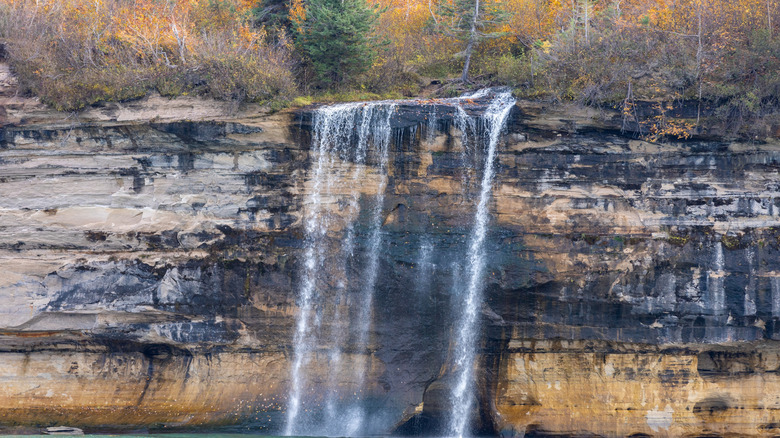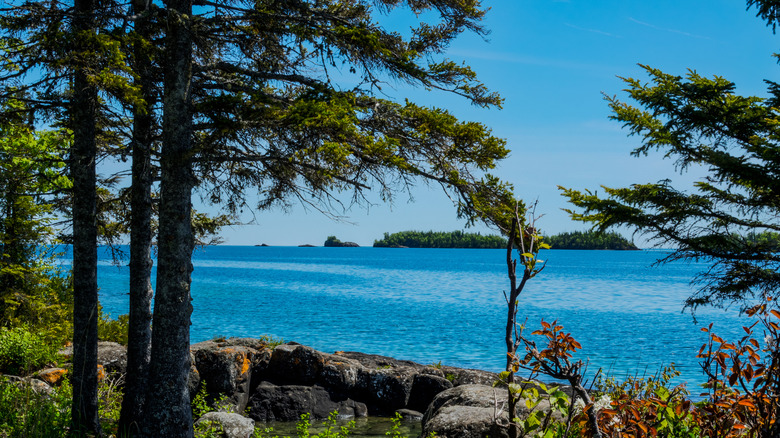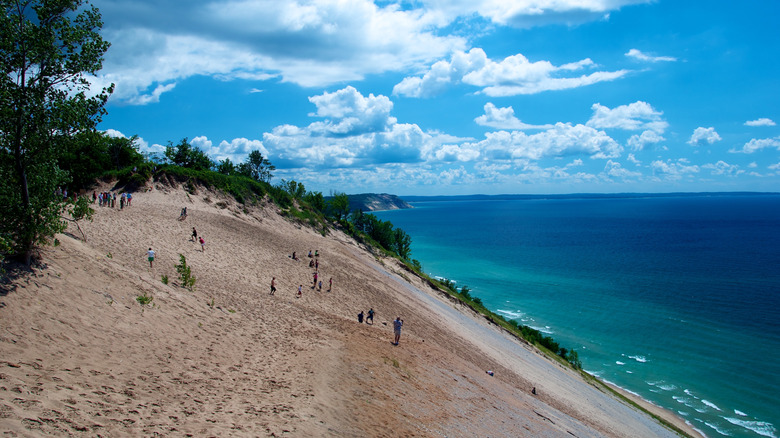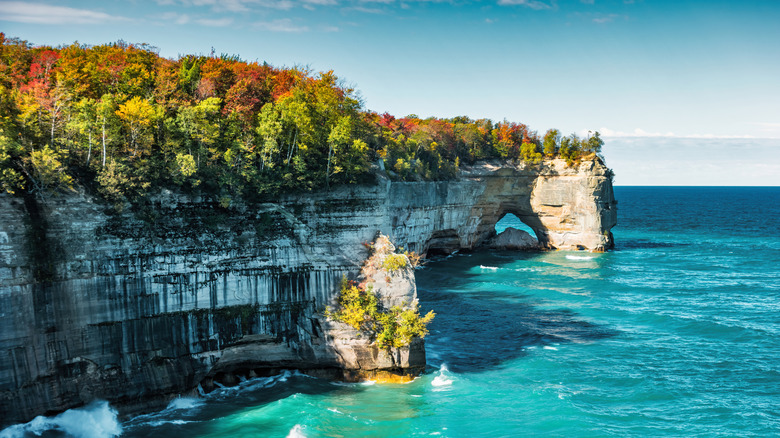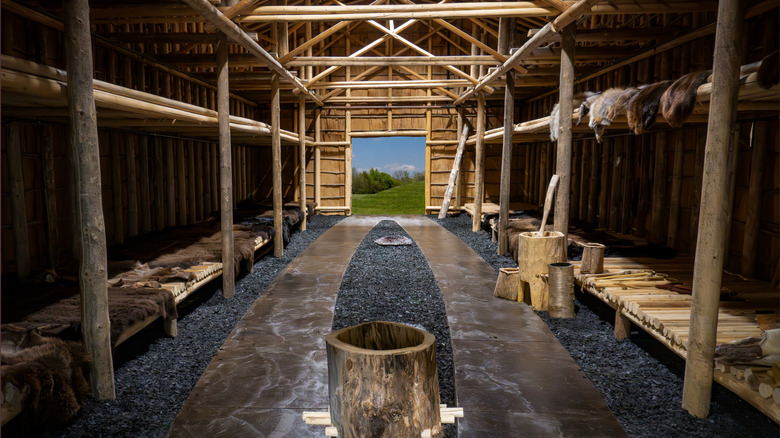Michigan's Best National Parks And Sites Offer Sand Dune Surfing, Shipwreck Tours, And Scenic Trails
A trip to Michigan isn't complete without a wander through one of the state's amazing national parks. The beauty of the Great Lakes state is that no one national park is the same. If ever there is a place in the country for your outdoorsy desires to be truly satisfied, it'll be in Michigan, where you can hike, explore cliffs, experience stunning coastlines, indulge in affordable mountain escapes that won't break the bank, and end the night stargazing in some of the most scenic locations in the U.S. One of the most unmissable experiences in Michigan is making it to one of the prized national parks that constantly attract travelers from within and beyond the country.
While the landscapes are guaranteed to leave visitors amazed at the biodiversity that Michiganders get to bask in daily, the parks offer a level of serenity and respect for history upheld by the National Parks Service since 1916. Each national park in Michigan has something unique, allowing visitors of all ages, mobility levels, and interests to experience the best that Michigan parks have to offer. Whether you're looking for glass-bottomed boat shipwreck tours that transport you back in time or remote islands to connect with the wilderness, Michigan will not disappoint.
Isle Royale National Park
Isle Royale is known to be one of Michigan's quieter national parks. It's therefore one of its best places to truly appreciate the state's nature at its purest and wildest. As the place is only by flight or boat, you can charter a seaplane from Grand Marais, Minnesota, or Houghton, Michigan; or take a ferry from Grand Portage in Minnesota or from Copper Harbor in Michigan. However you get there, this carless park located in the center of Lake Superior is hard to overlook. Winning numerous awards for its stripped-back beauty and lack of crowds, Isle Royal is one of Michigan's most treasured parks. Locals and travelers alike enjoy it for its hiking trails and campsites. Isle Royale is open from April 16 to the end of October annually, so avoid visiting this national park at the wrong time of the year if you want to make the most of the island.
The rugged forests, paired with the remoteness, makes for an island park experience that brings you into the intimacy of nature. As part of this, your hikes will give you the chance to spot moose and loons and gaze into the amazing views around the lake. Popular activities include kayaking (though waters may get a little rough at certain times of the year) or canoeing as well as expeditions to learn about the wildlife on this island that is so far from the connected community.
Sleeping Bear Dunes National Lakeshore
If your love for adventure is what brings you to the gates of national parks, then the Sleeping Bear Dunes might deserve a spot at the top of your list. As far as Midwestern beaches go, the coastline at Sleeping Bear Dunes is pretty hard to beat. The national park promises crystal clear waters, glacial moraines, and high dunes. The thrill of "skiing" or sledging down the dunes attracts tourists year in and year out, though be careful to avoid climbing Sleeping Bear Dune Climb. Other activities offered at Sleeping Bear Dunes national park are guided star-gazing and snowshoeing. There is beauty to be found in this national lakeshore year-round, but showing up in summer will allow you to enjoy warmer weather and pristine waters.
For avid hikers and those keen to explore the more traditional park activities, Sleeping Dunes is famed for its unique flora and fauna, including black bears, coyotes, and bald eagles, as well as nearby farmsteads. There is so much see at the 111-mile site that visitors can easily plan a multi-day trip. It might be worth packing your swim suit, as taking a dip is a popular thing to do. So is getting a close-up look at the South Manitou Island Lighthouse. The Heritage Trail is also a top-of-list activity for those interested in the maritime and agricultural history and can take you from campgrounds to local villages like Glen Arbor and the Port Oneida Historic District.
Keweenaw National Historical Park
In the northernmost part of the state, on the Upper Peninsula of Michigan, Keweenaw National Historical Park offers a refreshingly different offering to the collection of enticing national parks in the state. Steeped in history, Keweenaw is one to add to the list of places to learn about the legacy and history of the Native Americans and their 7,000-year-old copper-mining tradition. You can also learn about the development of migration during the great mineral rush in the 19th century, which was a pivotal moment for the state's history. Founded in 1992, Keweenaw honors this history, but it's also full of natural wonders of its own. Adventure lovers will be glad to know that it is famously home to the world's oldest and biggest lava flow, named the Greenstone Flow, which formed over a billion years ago and has since hardened into one of the most amazing cliffs in Michigan. Keweenaw National Historical Park is accessible throughout the year, but as with most of the Upper Peninsula region, the foliage in the fall season is sure to offer mesmerizing sights.
Beyond the wealth of historical knowledge, it is also a great place for breathtaking lakeside and mountainous views. On site, visitors can also delve deeper into history while wandering through the majestic sights with self-guided tours through the opera house, which is still in operation today. There is also the option to spend time at popular nearby sites such as the Eagle River Museum, the Copper Range Historical Museum, and Eagle Harbor Lighthouse to make a full day out of the trip.
Pictured Rocks National Lakeshore
With its signature streaks of layered mineral stains, Pictured Rocks is a great sightseeing destination. Famous for its picturesque colorful cliffs, this is one of Michigan's most popular tourist sites. Located in Munising, Pictured Rocks National Lakeshore is one of the top places to indulge in the beauty of the Midwest's natural landscape. While it makes for a great summer trip for the family, Pictured Rocks is a year-round delight with activities like waterfall hikes, ice-climbing, ice fishing, and snowmobiling as well as opportunities for scenic treks in the fall admiring Michigan's rich autumnal foliage. By far one of the greatest attractions is a pair of shipwrecked boats that can be explored during an afternoon of scuba diving or glass-bottomed boat rides. The two shipwrecked boats, the Bermuda and the Herman H. Hettler, sit at the bottom of Lake Superior, waiting to be explored.
With over 12 miles of beaches to wander, over 100 miles of hiking trails, 17 waterfalls, and access to the Grand Sable Dunes, there is something for everyone to enjoy at this national lakeshore. There are several ways to admire Lake Superior up close and personal or at a distance including paddling, kayaking, or birding during the warmer seasons. The rare landscape is also a perfect place for campers to take in the breathtaking sights. Head to the park's camping sites to properly spend a night in nature and sit around a campfire in one of the country's most flawless natural sites.
River Raisin National Battlefield Park
Abounding in history and vast grounds, the River Raisin National Battlefield Park is rife with opportunities to delve deeper into important events that are seeped into the soil and memory of the city of Monroe. It is the only place served by the National Park System that showcases the history of the War of 1812 and preserves the January 1813 battle plus its effects on modern-day Southeast Michigan. Located a short 35 miles from Detroit, it is also an ideal day trip for those looking to enjoy one of the most undisputed artsy centers in the country.
As far as Michigan's national park's go, River Raisin National Battlefield is definitely a top destination for history buffs and those looking for a day of family-friendly interactive learning. Travelers can find dioramas as well as historical firearms and exhibits including full-sized models of indigenous, American, and British soldiers. There is also a detailed fiber-optic map presentation to get a fuller glimpse at how the War of 1812 unfolded. Established in October 2010 and officially opening to the public in May 2011, the River Raisin National Battlefield Park has become one of the most important archives of U.S. battle history, with preserved canons and various monuments within the museums. Entry is free and open all year with the exception of Thanksgiving, Christmas, and New Year's Day.
